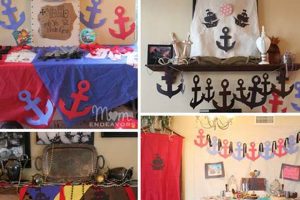Creating ornamental jellyfish representations at home allows for personalized aquatic-themed embellishments. These homemade adornments, frequently crafted from materials like paper lanterns, plastic bags, or fabric strips, offer an alternative to commercially produced decorations. The process often involves assembling a central body and attaching trailing tentacles to mimic the form of a jellyfish.
The appeal of constructing these decorations lies in their cost-effectiveness and the opportunity for creative expression. Utilizing recycled materials aligns with sustainable practices while providing unique decorative pieces. Historically, homemade decorations have served as a way to personalize living spaces and celebrate occasions without incurring significant expense. The creation process can also serve as an engaging activity for both children and adults.
Subsequent sections will detail various techniques for assembling these decorative items, focusing on different materials and skill levels. The information will include guidance on selecting appropriate materials, step-by-step instructions, and potential modifications for enhanced visual appeal.
Essential Construction Guidelines
The following guidelines aim to optimize the creation of decorative jellyfish, ensuring both aesthetic appeal and structural integrity.
Tip 1: Material Selection. Prioritize materials based on desired visual effect and durability. Lightweight fabrics, such as tulle or organza, create ethereal tentacles. Consider using recycled plastic bags for water resistance, especially if the decoration will be exposed to moisture.
Tip 2: Tentacle Attachment. Employ secure attachment methods for the tentacles. Hot glue, while efficient, may weaken over time; consider using needle and thread for a more durable bond, particularly when working with heavier materials. Distribute the tentacles evenly around the central body to maintain balance.
Tip 3: Color Palette Coordination. Select a cohesive color palette to enhance visual harmony. Monochromatic schemes or analogous color combinations often yield sophisticated results. Introduce contrasting colors sparingly to highlight specific features.
Tip 4: Illumination Integration. Incorporate LED lights for enhanced visual impact, particularly in low-light environments. Battery-operated lights offer convenience and safety. Ensure that the wiring is concealed and secured to prevent damage or malfunction.
Tip 5: Size Proportionality. Maintain size proportionality between the body and the tentacles. Overly long or numerous tentacles can overwhelm the central structure. Experiment with different lengths and densities to achieve visual balance.
Tip 6: Weight Distribution. Account for weight distribution to ensure the decoration hangs correctly. Distribute weight evenly throughout the structure, adding small weights if necessary to counteract imbalances. Consider the suspension point’s load-bearing capacity.
Tip 7: Secure Suspension. Utilize a robust suspension system to prevent accidental detachment. Fishing line or sturdy cord are suitable options. Ensure the suspension point is adequately reinforced to support the weight of the decoration.
Adherence to these guidelines promotes the creation of visually appealing and structurally sound decorative jellyfish. Careful planning and execution are essential for achieving professional-quality results.
The subsequent section will explore specific design variations and advanced techniques for crafting more intricate and elaborate decorative jellyfish.
1. Material Selection
The success of crafting ornamental jellyfish representations at home, classified under the term “diy jellyfish decorations,” is inextricably linked to material selection. The chosen materials directly influence the aesthetic qualities, durability, and overall feasibility of the project. For example, selecting lightweight, translucent fabrics like organza or tulle will create a delicate, ethereal effect, mimicking the natural translucence of a jellyfish. Conversely, utilizing heavier, opaque materials such as felt or thick plastic will yield a more substantial, cartoon-like appearance. The structural integrity of the decoration is also directly impacted; improperly chosen materials may lack the necessary strength to support the design, leading to sagging or disintegration. The availability of materials, budgetary constraints, and intended environment for display are further factors that influence material choices.
The selection process extends beyond the primary body and encompasses tentacle construction. Materials such as yarn, ribbon, plastic strips, or even recycled shopping bags can be employed to simulate the flowing tentacles of a jellyfish. The texture, color, and movement of these materials contribute significantly to the overall visual impact. For decorations intended for outdoor use, water-resistant materials are essential to prevent deterioration. Furthermore, the ease of manipulation and assembly affects the construction process. Materials that are difficult to cut, glue, or sew may increase the complexity and time required for completion. Practical applications include selecting glow-in-the-dark paint for nighttime displays or incorporating reflective materials for increased visibility.
In conclusion, material selection is a foundational element of “diy jellyfish decorations,” dictating the aesthetic, structural, and functional properties of the final product. Thoughtful consideration of material characteristics, intended use, and available resources is crucial for achieving satisfactory results. Challenges may arise in sourcing specific materials or adapting designs to accommodate available options. However, understanding the impact of material selection empowers individuals to create personalized and visually compelling decorations that effectively capture the essence of a jellyfish.
2. Tentacle Design
Tentacle design represents a critical element within the realm of homemade jellyfish decorations, significantly impacting the final product’s aesthetic appeal and realism. The tentacles, serving as the defining characteristic of jellyfish, directly influence the decoration’s visual impact. Variations in length, material, density, and color each contribute to a distinct impression. For instance, long, flowing strands of translucent fabric evoke a sense of graceful movement, while short, tightly curled ribbons create a more whimsical effect. The choice of materials influences not only the appearance but also the tactile qualities of the decoration.
The arrangement and attachment of tentacles are equally important. Even distribution around the central body ensures a balanced and visually pleasing design. Secure attachment methods, such as gluing or sewing, prevent detachment and maintain the structural integrity of the decoration. Furthermore, the degree of realism can be enhanced by incorporating details such as varying tentacle lengths and subtle color gradients. Consider examples where crafters incorporate fiber optic strands into the tentacles to simulate bioluminescence, significantly augmenting the decoration’s visual interest. The practicality of these designs translates directly into their marketability and perceived value, especially in contexts like themed parties or children’s room decor. Failures in tentacle design, such as uneven distribution or weak attachment, lead to an unbalanced or easily damaged product, diminishing its appeal.
In conclusion, effective tentacle design is indispensable for successful homemade jellyfish decorations. This design impacts the decoration’s visual appeal, realism, and structural integrity. Careful consideration of material selection, arrangement, and attachment methods is crucial for achieving a balanced and aesthetically pleasing final product. Overlooking these design elements can result in a subpar decoration, highlighting the practical significance of understanding and implementing proper tentacle design principles.
3. Color Harmony
Within the sphere of homemade jellyfish adornments, designated by the term “diy jellyfish decorations,” color harmony plays a pivotal role in determining the visual impact and aesthetic appeal. The selection and arrangement of colors significantly influence the perceived realism, mood, and overall attractiveness of the finished piece. Disharmonious color combinations can detract from the intended aquatic theme, rendering the decoration unappealing. Conversely, a well-executed color palette enhances the design, creating a visually cohesive and captivating representation of a jellyfish. For example, employing analogous colors, such as shades of blue and green, evokes a sense of oceanic tranquility, aligning with the natural environment of jellyfish.
The application of color theory informs effective color harmony in these decorations. Complementary colors, when used strategically, can create visual contrast and highlight specific features. Consider a jellyfish with a vibrant purple body and contrasting yellow tentacles, drawing attention and adding visual interest. Monochromatic schemes, utilizing varying shades of a single color, offer a sophisticated and elegant aesthetic. In a child’s room, pastel shades create a playful and inviting atmosphere, while darker, more saturated colors lend a dramatic effect to themed events. Practical applications extend to color psychology, where specific colors are associated with certain emotions or concepts. Blue is often linked to calmness and serenity, while bright reds and oranges evoke energy and excitement.
In summation, color harmony is an indispensable component of crafting visually compelling “diy jellyfish decorations.” The deliberate and thoughtful selection and arrangement of colors contribute significantly to the overall aesthetic and perceived realism of the finished product. A grasp of color theory and its practical application is essential for achieving harmonious color schemes that enhance the decoration’s visual impact and align with its intended purpose. A failure to consider color harmony could result in a visually unappealing creation, undermining the time and effort invested in its construction. The careful planning of color choices is, therefore, vital for successful and aesthetically pleasing results.
4. Lighting Options
The integration of lighting options within homemade jellyfish decorations significantly enhances their visual appeal, transforming them from static crafts into dynamic representations of marine life. Lighting introduces a crucial element of realism, mimicking the bioluminescent properties observed in many jellyfish species. The selection of specific lighting technologies directly influences the achieved effect, ranging from subtle ambient glows to vibrant, pulsating displays. Battery-operated LED lights are commonly employed due to their safety, energy efficiency, and ease of integration. These can be strategically positioned within the jellyfish body or along the tentacles, casting light through translucent materials and creating a captivating underwater illusion. The absence of integrated lighting often results in a less compelling and visually subdued decoration.
Practical applications extend beyond mere aesthetics. Lit decorations serve as unique nightlights in children’s rooms, providing a comforting and visually stimulating presence. At themed events or parties, illuminated jellyfish can create an immersive aquatic atmosphere, enhancing the overall ambiance. Specific lighting configurations, such as color-changing LEDs, allow for customization and adaptation to various moods and settings. The durability and weather resistance of the lighting components are critical considerations, particularly for outdoor applications. Additionally, the power source and battery life impact the practicality of the decoration, influencing its longevity and ease of maintenance. A well-executed lighting design transforms a simple craft project into a sophisticated decorative element.
In conclusion, lighting options are integral to the success of homemade jellyfish decorations. The deliberate selection and integration of lighting technologies significantly enhance their visual impact, realism, and versatility. While unlit decorations may serve a purely decorative purpose, those incorporating lighting elements offer a more compelling and engaging representation of marine life. The effective use of lighting elevates the craft, transforming it into a functional and visually stunning piece of art.
5. Suspension Method
The selection and implementation of a suitable suspension method are critical for successfully displaying crafted jellyfish decorations. The chosen method directly impacts the aesthetic presentation, structural integrity, and overall safety of the suspended art piece. A poorly executed suspension system can detract from the visual appeal, compromise the decoration’s stability, and pose a potential hazard.
- Load Capacity and Material Strength
The suspension method must accommodate the weight of the decoration. Materials like fishing line, twine, or wire should be selected based on their tensile strength. Exceeding the load capacity results in breakage, causing the decoration to fall and potentially sustain damage or cause injury. Considerations for material degradation over time, especially in humid or sunny environments, are also paramount.
- Aesthetic Integration
The suspension component should seamlessly blend with the decoration’s overall design. Transparent fishing line provides an unobtrusive suspension, allowing the focus to remain on the jellyfish itself. Alternatively, decorative cords or ribbons can be integrated to enhance the aesthetic, complementing the color scheme or theme. The chosen suspension material must not detract from the artistic merit of the overall piece.
- Attachment Security
The point of attachment on the jellyfish decoration itself must be robust and secure. Reinforcing the attachment area with additional glue or stitching can prevent detachment. Even weight distribution across multiple attachment points minimizes stress on any single area. The attachment should withstand movement or minor impacts without failing, ensuring long-term stability.
- Environmental Considerations
The surrounding environment influences the choice of suspension method. For outdoor installations, weather-resistant materials are essential to prevent corrosion or degradation. Indoor installations require consideration of ceiling type and available mounting hardware. Temporary installations may utilize adhesive hooks, while permanent installations necessitate more secure hardware like screw-in hooks or anchors. Safety and suitability for the intended environment are primary concerns.
The various facets of the suspension method, when effectively addressed, ensure that these decorative jellyfish are displayed safely and attractively. Neglecting these considerations compromises the visual impact and longevity of the crafted art piece. Careful planning and appropriate execution are essential for achieving a successful and visually pleasing suspension.
Frequently Asked Questions
The following addresses common inquiries regarding the creation and implementation of homemade jellyfish decorations, providing concise and informative answers.
Question 1: What materials are most suitable for creating the jellyfish body?
Lightweight, translucent materials such as paper lanterns, plastic bowls, or fabric scraps are recommended. These materials effectively mimic the semi-transparent nature of jellyfish and are generally easy to manipulate.
Question 2: How can the tentacles be made to appear more realistic?
Employing a variety of materials, such as ribbon, yarn, plastic streamers, or fabric strips, adds visual texture and depth. Varying the lengths and thicknesses of the tentacles also enhances realism. Employing curling techniques will further augment the lifelike appearance of the tentacles.
Question 3: What is the most secure method for attaching the tentacles to the jellyfish body?
Hot glue provides a quick and effective bond, particularly for porous materials. Sewing offers a more durable and long-lasting attachment, especially when working with fabrics. The selected method should be appropriate for the materials used and the intended lifespan of the decoration.
Question 4: How can the decorations be illuminated to enhance their visual appeal?
Battery-operated LED lights, either strung along the tentacles or placed inside the jellyfish body, provide a safe and visually striking effect. Consider using color-changing LEDs to mimic the bioluminescence of some jellyfish species. Ensure proper insulation and secure placement of the lights.
Question 5: What considerations are important when suspending the jellyfish decorations?
The weight of the decoration should be taken into account when selecting the suspension material. Fishing line offers a discreet and strong option. Ensure the hanging point is secure and capable of supporting the weight. Consider the environmental factors, such as wind or humidity, if the decoration is intended for outdoor display.
Question 6: How can the decorations be customized to fit a specific theme or color scheme?
Selecting materials and colors that complement the desired theme is essential. Embellishments such as glitter, sequins, or paint can be added to further customize the decorations. Consider incorporating thematic elements, such as seashells or nautical motifs, to enhance the overall effect.
In summary, creating impactful and visually appealing homemade jellyfish decorations requires careful attention to material selection, attachment methods, lighting options, and suspension techniques. Customization allows for adaptation to various themes and aesthetic preferences.
The next section will offer design variations and inspiration for creating unique and elaborate jellyfish decorations.
Conclusion
The preceding exploration of crafting ornamental jellyfish, known as “diy jellyfish decorations,” has delineated essential aspects, ranging from material selection and tentacle design to color harmony, lighting integration, and suspension methods. Mastery of these techniques enables the creation of visually compelling and structurally sound decorations suitable for diverse applications.
Effective implementation of these principles fosters creativity and promotes the production of personalized, environmentally conscious decorative elements. Continued exploration of innovative materials and design modifications promises further advancements in the art of creating these aquatic-themed adornments, encouraging ongoing experimentation and refinement.







